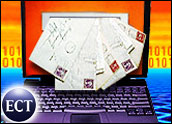
America Online, the largest Internet service provider, said it would stop using Microsoft’s Sender ID technology to filter unwanted e-mail being sent to its millions of members, and instead embrace an open-source friendly alternative.
AOL’s decision came just days after a subgroup of the Internet Engineering Task Force (IETF) said it was unable reach consensus on how Sender ID, which is widely viewed as a strong antispam technology, could be integrated with other tools. A major stumbling block for the Task Force was the fact that Microsoft has laid patent claims on Sender ID.
“Given recent concerns expressed by the IETF coupled with the tepid support for Sender ID in the open-source community, AOL has decided to move forward with SPF-only checking on inbound e-mail at this time,” AOL said in a statement.
Sender ID and SPF
AOL will continue to include Sender ID data in outgoing mail to enable ISPs and others that use it to identify where messages originate. For incoming mail, the company said it would move forward with plans to establish Sender Policy Framework, or SPF, as the technology of choice, requiring that all of the bulk e-mailers that are cleared to send messages to its members to have the SPF data available.
The defection of AOL is seen as a major blow to Microsoft, which noted when the IETF made its decision that many large ISPs and telecommunications companies still supported its standard.
Microsoft was not available to comment for this story, but has said that it remains committed to developing the Sender ID protocol because it has already been widely embraced by the Internet industry.
Elephant in the Room
Ironically, both AOL and Microsoft have been among the most aggressive antispam crusaders, recognizing both the need to curb spam for their users and the positive publicity to be gained from being out front on the issue. The two have even joined forces as part of an alliance aimed at using both criminal and private legal means to stop spammers.
Such standards flaps are nothing new in the technology sector, but the battles often take on an added sense of urgency when Microsoft is involved, said Yankee Group senior analyst Laura DiDio.
“Having them in the picture makes some people nervous,” DiDio said. Microsoft’s saying it would offer a free license to at least part of the technology has done little to soothe those frayed nerves. “For the purposes of the stopping spam, the development of a single standard isn’t as important as there’s compatible technology,” she added.
FTC Chimes In
The Federal Trade Commission (FTC), meanwhile, said it will host an industry summit meeting to push for consensus on the best approaches for using e-mail identifiers to control spam.
The workshop will be a follow-up to the FTC investigation into a proposal to reward consumers who report spammers who are brought to justice under the CAN-SPAM Act, which went into effect at the start of 2004.
FTC spokesperson Claudia Bourne-Farrell told the E-Commerce Times that the summit is a response to its decision not to back a proposal to create a do-not-e-mail list similar to the national do-not-call registry aimed at stemming unwanted phone solicitation.
“The agency wants to hear what the challenges are toward using identification more effectively,” Farrell said. She noted that the summit will come near the end of the first year of CAN-SPAM’s implementation.
Separately, the FTC said Thursday in a report that had been requested by Congress that attempts to use bounties or rewards to insiders who turn in potential spammers for prosecution would have to include large bounties of as much as $250,000 to make it worthwhile.






















































SMTP should not continue to live…it has outlived its geeky usefulness.
Private email networks, using a simple web browser with the HTTP protocol and web services behind the scenes connecting all of the private networks together. It’s like a P2P system, but has some central control to coordinate who is who.
That is the future.
I think it is being made out to be more political that it should be as well. But I cannot stand the presence of SPAM!
Yes,
but people are makeing the Story to political.
SPF is simply the better choice on your SMTP Server since it really reduced the traffic since
it checks the envelope (which cannot be forged).
Sender ID uses the same mechanism but uses the Mime Header. That means that Sender ID doesnt make
sense to use it on a Server to reduce Traffic.
Thats why Sender ID suits more as Plugins for
Mail Clients…..
We are supporting SPF fully in our Aloaha.
Sender ID we are using as well but only to
check the published records. From that point
onwards we treat them as SPF1 since we want
to reduce the SPAM Traffic on your Server…
FH